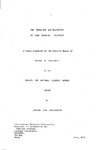THE FORMATION AND REACTIVITY OF SOME NONMETAL SILICIDES
| dc.contributor.author | BROCKINGTON, BERTRAM JOHN | |
| dc.contributor.other | School of Geography, Earth and Environmental Sciences | en_US |
| dc.date.accessioned | 2013-10-18T12:34:22Z | |
| dc.date.available | 2013-10-18T12:34:22Z | |
| dc.date.issued | 1973 | |
| dc.identifier | NOT AVAILABLE | en_US |
| dc.identifier.uri | http://hdl.handle.net/10026.1/2232 | |
| dc.description.abstract |
Boron silicides, B₄Si and B₆Si, have been produced by calcining mixtures of finely-divided boron and silicon at different temperatures and information obtained regarding the process mechanism. There are optimum reaction times for the formation of B₄Si, before it disproportionates into B₆Si and Si. The atmospheric oxidation of boron silicides is retarded by the product layers of boric oxide, B₂O₃, and silica, SiO₂, and also by their mineralising action promoting sintering of the material. Boron silicides may be used only in an oxidising environment at lower temperatures (500 - 800°C) without severe degradation occurring if they have been first subjected to oxidation at higher temperatures (ca. 1000°C) in order to form a protective coating. | |
| dc.language.iso | en | en_US |
| dc.publisher | University of Plymouth | en_US |
| dc.title | THE FORMATION AND REACTIVITY OF SOME NONMETAL SILICIDES | en_US |
| dc.type | Thesis | |
| dc.identifier.doi | http://dx.doi.org/10.24382/4949 | |
| dc.identifier.doi | http://dx.doi.org/10.24382/4949 |
Files in this item
This item appears in the following Collection(s)
-
01 Research Theses Main Collection
Research Theses Main


